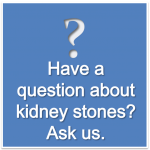 In our “Ask a kidney stone doctor” section, we field questions from stone formers or their family members. Today’s question is about cystine stones in a 5 year old boy. See other questions and answers or ask your own question here.
In our “Ask a kidney stone doctor” section, we field questions from stone formers or their family members. Today’s question is about cystine stones in a 5 year old boy. See other questions and answers or ask your own question here.
July 21, 2011
Question from a father of a cystine stone former:
I have a five year old son who is suffer from 100 % cystine kidney stone .He is totally four time operated for this but no any permanent solution.The stone size is genarally 30 mm in six month and specially in right side kideny.The doctor suggest me for Urinary cystinine 24 hr test i dont where it’s best laboratory.kindely suggest me the treatment procedure or suggest me the best Doctors name where i can foun my solution. [sic]
Answer:
Cystine stones are caused by an inherited condition. These stones can be very difficult to treat as they are very likely to recur.
The 24 hour urine test is used to determine whether your son has inherited one gene (heterozygous) or two genes (homozygous). Homozygous patients have the more severe form of the condition, making their treatment more difficult. I would recommend you discuss with your local doctor where to send the test because not all laboratories will be able to run this test.
Surgery can remove stones once they develop but cystine stones will always redevelop. Therefore, medical treatment is an important part of cystine stone management. There are three strategies that make up medical therapy for cystine stone formers:
1) Alkalinization
Cystine solubility (how likely it will dissolve) is dependent on the pH of urine. A high pH (alkaline) can cause cystine stones to dissolve and make new stones less likely to form. Medications can be used to change the pH of a patient’s urine. Common medications include potassium citrate tablets, powders, or oral solutions. The goal pH for cystine stone formers is between 7.2 and 7.5.
2) Binding
The solubility of cystine can be increased by binding it to other molecules. Two medications have generally been used for this purpose. The first is D-penicillamine (Cuprimine). However, it is poorly tolerated by patients because of side effects, and over 50% of patients discontinue the medication. The second binding medication is alpha mercaptopropionylglycine (Thiola). This medication has similar effectiveness to D-penicillamine but has lower side effects and is better tolerated.
3) Fluid intake
Increasing the amount of fluid drank throughout a day will cause the urine to become dilute, which lowers the concentration of cystine. The goal is to keep the urine clear. Fluid intake alone will usually not halt cystine stone formation but can be effective when combined with alkalinization and binding medications.
We suggest that you work with your local doctor to not only treat your son’s stones surgically but to also decrease future stones with the three strategies above.
Ok so i went to the ER found out i had a kidney stone becausee i had blood in my urine and pain in my back only that day next day my urine was clear and pain was gone wasnt bad pain didnt feel nothing come out does this mean it broke apart and its gone wasnt painful
I hope you passed it, but it could be the stone isn’t impeding urine flow and has just shifted. I have stones in both kidneys that don’t cause pain most days but when they ‘shift’ it can put me on my knees.